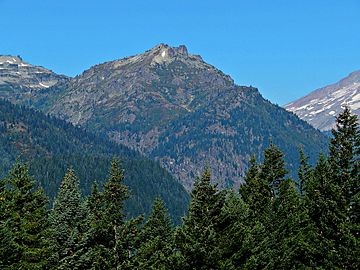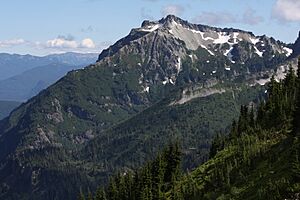Stevens Peak facts for kids
Quick facts for kids Stevens Peak |
|
|---|---|

Stevens Peak east aspect from Stevens Canyon Road
|
|
| Highest point | |
| Elevation | 6,560 ft (2,000 m) |
| Prominence | 760 ft (230 m) |
| Geography | |
| Location | Mount Rainier National Park Lewis County, Washington, U.S. |
| Parent range | Cascades |
| Topo map | USGS Tatoosh Lakes |
| Climbing | |
| Easiest route | Scrambling |
Stevens Peak is a tall mountain, standing at 6,560 feet (about 2,000 meters) high. It is part of the Tatoosh Range, which is a smaller group of mountains within the larger Cascade Range. You can find Stevens Peak inside Mount Rainier National Park in Washington state, just one mile east of another peak called Unicorn Peak.
The mountain was named to honor Hazard Stevens. He was one of the first people to successfully climb Mount Rainier back on August 17, 1870, along with P. B. Van Trump. The name "Stevens Peak" became official in 1913. Water from rain and melting snow on the mountain flows into streams that eventually join the Cowlitz River.
Discover the Climate at Stevens Peak
Stevens Peak is located in a "marine west coast" climate zone. This means it has mild temperatures and lots of rain or snow, similar to coastal areas. Most of the weather systems that affect the mountain come from the Pacific Ocean. They travel northeast towards the Cascade Mountains.
When these weather systems hit the tall peaks of the Cascades, they are forced to rise. As the air goes higher, it cools down and drops its moisture as rain or snow. This process is called "orographic lift." Because of this, the western side of the Cascades gets a lot of precipitation, especially heavy snowfall in winter.
The climate here is generally mild. Temperatures rarely drop below 0°F (-18°C) or go above 80°F (27°C). During winter, it's often cloudy. But in summer, high-pressure systems over the Pacific Ocean usually bring clear skies. The snow here tends to be wet and heavy due to the ocean's influence. This can sometimes lead to a higher risk of avalanches.
Explore More About Stevens Peak
- National Park Service web site: Mount Rainier National Park
- Weather forecast: Stevens Peak



